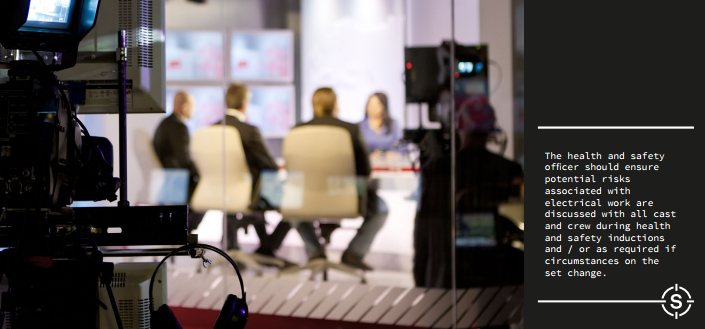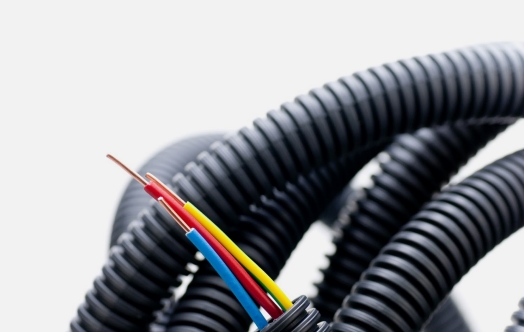This chapter provides guidance in relation to electrical safety on a production, and is primarily based on
New Zealand legislation and guidance issued by WorkSafe NZ, the BBC and IEE Wiring Matters.

Section 5
Electrical
Who needs to read this?
All workers who undertake electrical work should read and understand the section on ‘minimum responsibilities’.
Any person who is responsible for supplying electrical equipment to a production, both from the supply company and the production company; as well as any person who plugs anything into the electrical supply.
Roles that have specific responsibilities, or influence, over electrical work should read the section on ‘planning and guidance considerations’ – this includes producers, directors, production managers, line producers, heads of departments, assistant directors and health and safety officers.
Definitions
Competent means a person who has through a combination of training, education and experience, acquired knowledge and skills enabling that person to correctly perform a specified task.
Qualified electrician is a person who has both a current electrical registration and practicing licence.
RCD is a Residual Current Device.
What specific electrical risks are there on production sets?
- Arcing.
- Electric faults can result in a fire.
- Contact with electricity causing electrical shock and/or burns.
- Exploding bulbs/lamps.
- Generators incorrectly specified/setup for use.
- Power overload.
- Equipment falling over and causing injury.
- Electric cables and wires may create a trip hazard.
- Using electrical equipment in higher risk environments: wet, damp, humid, dusty conditions, increases the hazards significantly.
- Overhead obstructions.
- Radiation burns.
- Batteries can cause fire if the terminals come into contact with conductive materials.
Minimum responsibilities for electrical work
Everyone on a screen production should read and understand this section.
If you have planning responsibilities for, or planning influence over, electrical work you also should read and understand the following section on planning and guidance considerations and responsibilities.
If you undertake or are responsible for, or have influence over, electrical work you should also read and understand the section on responsibilities specific to electrical work.
Only those persons accredited under relevant legislation shall be engaged to undertake electrical maintenance and or installation.
If electrical equipment starts to burn or smoke:
- isolate the electrical supply if possible;
- use carbon dioxide or dry powder extinguisher, if competent to do so, but do not put yourself in danger;
- avoid inhaling fumes from burning plastics; and
- call emergency services – dial 111.
All workers should:
- have a basic knowledge of electrical safety, if they are expected to handle electrical equipment;
- understand the risks associated with electrical work;
- ask the gaffer/electrician before plugging any cable into a distribution board/socket;
- immediately advise the producer, or person with delegated responsibility, and electrics crew of all potential electrical hazards;
- use personal protective equipment when required; and
- advise their supervisor or the health and safety advisor when they observe unsafe electrical work.
Workers should never:
- place liquid (drinks) on any electrical appliance or fitting;
- walk jton, drive over, or stand on cables – sudden or continuous weight can create a weak point in the cable and cause an electrical fault; and
- attempt to investigate or repair faulty equipment unless they are qualified.
Planning and guidance considerations and responsibilities
Everyone has planning responsibilities for, or planning influence, over electrical work should read and understand this section, as well as the minimum responsibilities for everybody.
This includes funders, the production company, producers, heads of departments, and health and safety advisors.
Anyone who is responsible for or undertakes electrical work should also read and understand the next section – responsibilities specific to electrical work.
Funders
Funders should:
- be assured, through the provision of the production’s health and safetyplan, that the funding provided is adequate to provide for competent people to undertake and supervise all electrical work and appropriate electrical
equipment.
Production Company
In pre-production, production companies (likely to have primary responsibility over health and safety on the production) should:
- ensure that at least one member of the crew dealing with electrical matters is suitably qualified;
- consider the potential risks associated with electrical work when planning and allocating tasks;
- ensure the potential risks associated are appropriately managed, either eliminating or minimising them; and
- engage competent persons to oversee and undertake all electrical work associated with the production.
Producer / Production manager
As producers and production managers have oversight across the production, they should:
- engage competent people to undertake and / or supervise electrical work;
- consider the potential risks associated with electrical work when planning and allocating tasks;
- manage the potential risks associated with electrical work, either eliminating or minimising them;
- engage competent persons to oversee and undertake all electrical work associated with the production;
- ensure all crew are advised of any electrical hazards as necessary and immediate steps must be taken to eliminate or minimise the risk; and
- consider whether a specialist company may be required to produce a suitable electrical design
Heads of Department
Heads of department’s whose department undertakes any type of electrical work should ensure a competent person undertakes that work and read the section on responsibilities specific to electrical work.
Health and safety officer
The health and safety officer should ensure potential risks associated with electrical work are discussed with all cast and crew during health and safety inductions and / or as required if circumstances on the set change.

Responsibilities specific to electrical work
Everyone who undertakes or is responsible for, or has influence over, electrical work should read and understand this section, as well as the previous sections.
This includes electricians, gaffers and anyone undertaking or with responsibilities or influence over electrical work on a production.
Anyone bringing electrical items to a production should also be aware of and comply with:
- AS/NZS 3760:2010 – specifies the requirements for safe inspection and testing of electrical equipment in the workplace.
Anyone undertaking electrical work must comply with the following standards:
- AS/NZS 3010 – all electrical work must be carried out in accordance with the Electricity Act 19922
and Electrical (Safety) Regulations 2010.3
- AS/NZS 4249:1994 – specifies the requirements for safe working practices in the use of electrical equipment on film, video and television sites and the in-service testing of the equipment, and must be followed.
- AS/NZS 3760:2010 – specifies the requirements for safe inspection and testing of electrical equipment in the workplace.
Any person responsible for, or with influence over, electrical work, likely to be the gaffer or head registered electrician, must ensure:
- all crew are advised of any electrical hazards as necessary and immediate steps must be taken to eliminate or minimise the risk;
- where practicable, all final circuits must be protected by a 30mA Residual Current Device (RCD);
- electrical work is carried out by a competent person, this is either a:
- registered electrician with current practising licence; or
- electrical service technician with current practising licence; or
- electrical appliance serviceperson with current practising licence; or
- person working under supervision of the above;
- the installation of fixing wiring and electrical equipment to production sets is carried out by a competent person, as define above;
- electrical equipment is well maintained;
- electrical equipment / devices are tested for function by a competent person – testing requirements must follow those outlined in legislation and NZ standards AS/NZS 3760:2010;
- electrical equipment whether onset, in offices or workshops display a current test tag to AS/NZS3760:2010
- leads are off the ground or protected where practicable;
- electrical equipment/devices are protected from the weather, or constructed to a suitable IP rating;
- cables and distribution are of sufficient size and capacity to do the required job;>
- cables are not twisted, crushed or kinked;
- cables are secured and clearly identified;
- cable routing is carefully considered and does not create a tripping hazard;
- power is turned off when installing power distribution equipment.
Minimum clearance between equipment and overhead electric power lines
Anyone supervising or operating equipment near or under power lines is responsible for ensuring the following is adhered to:
- Overhead power lines (conductors) are an often overlooked danger. Be alert for the presence of overhead conductors when operating cranes, boom swinging, carrying tall objects, being in a boat with a mast up on the water or on a trailer on land.
- When operating mechanical equipment near overhead electric power conductors the requirements of the Electricity Regulations 1993, clause 82 (3) and (5), and NZECP 34,1993 apply. There is a minimum clearance of four metres. Consult your local power supplier who may permit closer operation for lower voltages. Written permission is required to operate closer than four metres.
- When travelling on the road, the requirements of the Transport Act 1976 apply.
Overhead power lines (conductors) are an often overlooked danger. Be alert for the presence of overhead conductors when operating cranes, boom swinging, carrying tall objects, being in a boat with a mast up on the water or on a trailer on land.
Managing the risk
HOW DO I CONTROL RISKS ASSOCIATED WITH ELECTRICAL WORK?
First, you must consider whether you can eliminate the risk, if this is not reasonably practicable then you must minimise that risk – this is called the hierarchy of controls.
Appendix 2: health and safety risk assessments process will further help you understand how to use the hierarchy of controls.
THE RISK OF ELECTRICAL SHOCK FIRE4
Risks associated with temporary installations are those of electric shock and fire. These arise from:
- the temporary nature of the installation;
- lack of permanent structures;
- severe mechanical stresses; and
- access to the public.
Attention should be paid to:
- suitability of the equipment for the environment;
- earthing and bonding requirements;
- connection to the supply; and<
- use of accessories of the appropriate Degree of Protection (IP code) to suit the external influences.

Gaffer and / or head electrician
By law electricians have greater authority and responsibility than non-electricians in matters around electricity. If the head gaffer is not an electrician, the head electrician within the department, where the work is occurring, is responsible for all electrical items on the job.
Gaffers and / or the head electrician should:
If in doubt,
call it out!
Disconnection of power in adverse conditions
Electric shocks are a high risk in adverse climatic conditions and in some water locations. If the gaffer or electrician feels the risk is unacceptable, he/she should inform the producer or person with delegated responsibility that the power shall be disconnected until the situation is rectified.
Training
As part of all PCBUs primary duty of care to provide and maintain a safe and health work environment, they must ensure workers have had the necessary training to allow them to undertake their work safely.
Anyone who has direct oversight of electrical work should ensure the crew undertaking the task/s are adequately trained and competent in their work.
Things to think about include, does the worker require:
- a qualification to undertake the task;
- supervision by a competent person, if they are new or don’t have the required level of training?
- basic training teaching them how to undertake the task safely; or
- basic training teaching them how to ensure the risk control is effective, including use of personal protective equipment?



